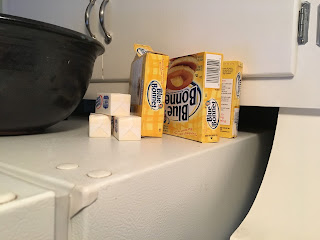Most of the baking I do for the holidays is based in family favorite cookie and bar recipes. (I'll be honest: I don't do a lot of cooking around the holidays, it's mainly just baking.)
 |
| Actual recipes tucked into the front of my binder-ed cookbook. |
 |
| The Betty Crocker is from 1950, my copy of Joy is from the 80s. No idea the age on the plaid-covered one on the far right. |
Today, though, as companies ever-so-subtly shrink - or enlarge - the contents of their packages, there can be all sorts of issues when you're in the kitchen.
Not sure what I mean? Well...
- The can of tuna I opened for lunch, yesterday, was 5 ounces - the ones I grew up with (which, really, looked the same) were 6 ounces.
- The standard package of chocolate chips I buy (when not shopping at Costco) is 12 ounces, but the chocolate chip cookie recipe I use calls for "one 6-ounce package" of chocolate chips.
- The boxed cake mix the mother of a friend of mine uses as her standard base for Christmas cakes has - at least in some areas - changed from 18 ounces to 15 ounces.
I'm a firm believer that time in the kitchen passing recipes from generation to generation is incredible - I know that I feel much more tethered to my past when I'm using the recipes that were handed down, possibly a little worn around the edges, and hand-written or typed out. I'm also a firm believer in making sure that the next generation can actually use the recipes.
So, please, as you're in the kitchen this season (or any time in the year), and you come across a "one can of..." or "one packet of..." notation in one of your recipes, do yourself - and everyone who will be asking you for the recipe - a favor and make a quantity note.
Unless, of course, it's a secret recipe - or the one ingredient that no one knows about but your great aunt. Obviously. There are some things that do need to be left to tradition.























